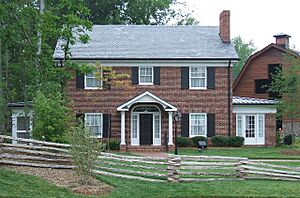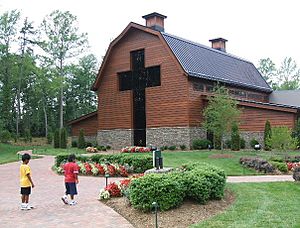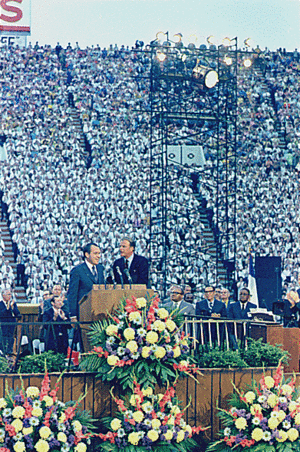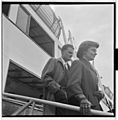Billy Graham facts for kids
Quick facts for kids
Billy Graham
|
|
|---|---|

Billy Graham, on April 11, 1966
|
|
| Born |
William Franklin Graham, Jr.
November 7, 1918 |
| Died | February 21, 2018 (aged 99) Montreat, North Carolina, U.S.
|
| Nationality | American |
| Education | Diploma in Biblical Studies, Florida Bible Institute (Trinity Bible College), 1940 B.A. in Anthropology, Wheaton College, 1943 |
| Occupation | Evangelist |
| Title | Doctor (Honorary) |
| Spouse(s) | Ruth Graham (m. 1943–2007; her death) |
| Children | Franklin, Nelson, Virginia, Anne Ruth |
| Signature | |
 |
|
William Franklin Graham, Jr. (born November 7, 1918 – died February 21, 2018), known as Billy Graham, was an American Christian preacher. He was a member of the Southern Baptist Convention, a large group of Christian churches. Many people see Graham as the most important and influential preacher of the 1900s.
He was a trusted friend and guide to several U.S. presidents. Billy Graham spoke in person to more people than almost anyone else in history. By 2002, his messages had reached over two billion people through radio and television. Graham met every United States President from Harry S. Truman onward. He received many awards, including the Congressional Gold Medal and the Presidential Medal of Freedom.
Who Was Billy Graham?
His Early Life
Billy Graham was born on a dairy farm near Charlotte, North Carolina. His parents, Morrow Coffey and William Franklin Graham, ran the farm. They were very religious Christians, and his mother greatly influenced his faith. An experience in 1933 made Billy and his sister dislike alcohol for the rest of their lives.
The Billy Graham Center says Graham became a strong Christian in 1934. This happened during a special Christian gathering in Charlotte led by evangelist Mordecai Ham. However, he didn't join a local youth group because he felt he was "too focused on non-religious things." After finishing Sharon High School in May 1936, Graham went to Bob Jones College (now Bob Jones University).
In his first year of college, he found the schoolwork and rules very difficult. He almost left school. But Bob Jones, Sr., the college founder, told him he would waste his life. He said to Graham, "At best, all you could be would be a simple country Baptist preacher somewhere out in the sticks... You have a voice that pulls. God can use that voice of yours. He can use it mightily."
While at college, Graham often took a canoe to a small island. There, he would practice preaching to the birds, alligators, and cypress trees. In 1937, Graham moved to the Florida Bible Institute (now Trinity College of Florida). Later, he transferred to Wheaton College in Illinois. In 1943, he earned a college degree in anthropology (the study of human cultures). At Wheaton College, Graham decided to believe the Bible was God's perfect word. A memorial marks the spot in Southern California where he made this important choice.
His Family Life
In 1946, Graham married Ruth Bell, who was in a class with him. Her parents were Christian missionaries in China. Her father, L. Nelson Bell, was a surgeon there. Graham said about Ruth, "She looked at me and our eyes met and I felt that she was definitely the woman I wanted to marry." Ruth said he wanted to please God more than any man she had ever met. They married two months after graduating from college. They lived in a log cabin that Ruth had built.
Ruth died on June 14, 2007, at age 87. They had five children: Virginia (Gigi) Graham Foreman, Anne Graham Lotz, Ruth Dienert, Franklin Graham, and Ned Graham. They also had 19 grandchildren and 28 great-grandchildren.
His Ministry Work
How It Started
Graham became a Southern Baptist minister in 1939. He then took over a radio program called "Songs in the Night." He hired a singer with a deep voice, George Beverly Shea, to be the music director for his ministry. The program was successful, but Graham left it in 1945. He wanted to be a religious leader in the military, but he got sick with mumps and couldn't join. After he got better, he started "Youth for Christ" with another preacher, Charles Templeton. He traveled across the United States and Europe as a preacher.
Becoming Famous
Graham held many special Christian gatherings in Los Angeles in 1949. These events are seen as the time when Graham became a well-known religious leader across the country. This happened because he received help from the powerful newspaper owner William Randolph Hearst. Many believe Hearst liked Graham because of his love for his country. Hearst also thought Graham could help with his strong beliefs against communism.
Hearst sent a message to his newspaper editors saying "Puff Graham," which meant to promote Graham. So, people could read much more about Graham in Hearst's newspapers and magazines. This meant his Los Angeles event lasted for eight full weeks, five weeks longer than planned. Henry Luce put Graham on the cover of Time magazine in 1954, making him even more famous.
Middle Years of Ministry
Graham held large events in London and at Madison Square Garden in 1957. The London event lasted 12 weeks, and the New York one was about 16 weeks. He also led his first event in Australia in 1959.
Graham was the president of Northwestern College in Minnesota from 1948 to 1952. He started many organizations, like the Billy Graham Evangelistic Association. He also spoke out against racial segregation (keeping people of different races apart) in the 1960s. Graham refused to speak to audiences that were separated by race. He even once removed ropes that had been put up to divide the audience. Graham helped Dr. Martin Luther King Jr. when he was in jail during the 1960s Civil Rights Movement. He asked King to join him on the stage at a gathering in New York City in 1957. During that 16-week tour, many people came to hear him at Madison Square Garden, Yankee Stadium, and Times Square. They became good friends, and Graham was one of the few white people King allowed to call him by his birth name, "Michael."
Later Years and Retirement
During the Cold War, Graham was the first evangelist to speak behind the Iron Curtain (a term for the border separating communist and non-communist countries in Europe). During the Apartheid era (a system of racial separation) in South Africa, Graham refused to go until the government allowed all people to sit together. He finally preached his first event there in 1973, where he taught that apartheid was wrong.
Graham visited China, where his wife Ruth was born. He also appeared in North Korea in 1992. On September 14, 2001, shortly after the September 11 attacks, Graham led a prayer service at the Washington National Cathedral. President George W. Bush attended this service. On June 24, 2005, he began what he said would be his last major event in North America. In March 2006, Billy Graham held the "Festival of Hope" in New Orleans, which was recovering from Hurricane Katrina.
Graham said he had to retire because of his declining health. He had Parkinson's disease for about 15 years, along with other health issues. In August 2005, though weak, he used a walker to attend the start of his library in Charlotte, North Carolina. In August 2007, Graham, at age 88, was treated for intestinal bleeding.
Billy Graham preached Christianity to nearly 215 million people in over 185 countries. He also reached hundreds of millions more through television, videos, movies, and webcasts. He led over 41 evangelistic events since 1948. He often used large areas like stadiums, parks, or big streets to speak. Groups of up to 5,000 people would often sing in a choir at his meetings. Graham would share his message and then invite people to come forward. In 1992, one-quarter of the 155,000 people in his Moscow audience came forward when he asked.
Graham died from Parkinson's disease on February 21, 2018, at his home in Montreat, North Carolina. He was 99 years old.
Billy Graham and Politics
In politics, Graham was a member of the Democratic Party, but he changed to the Republican Party during the time his friend Richard Nixon was president. He later said he didn't belong to any political party, because he believed Jesus did not have a political party. While he generally didn't support specific politicians, he did give his support in some cases over the years.
Friend to Presidents
Graham met every United States President since Harry S. Truman. He became close friends with Vice-President Richard Nixon while playing golf. Dwight D. Eisenhower asked to see Graham when he was dying. Graham also worked with Lyndon B. Johnson, Gerald Ford, Jimmy Carter, Ronald Reagan, Bill Clinton, the Bush family, and Barack Obama. Obama visited Rev. Graham at his home in Montreat, North Carolina for a private prayer.
Graham played golf with John F. Kennedy, even though Kennedy was a Roman Catholic. Graham spent the last night of Johnson's presidency in the White House. He was also there for the first night of Nixon's presidency. Nixon appeared at one of Graham's events in East Tennessee in 1970. It had one of the biggest crowds ever in Tennessee. However, their friendship became weaker because Graham didn't approve of Nixon's behavior after the Watergate scandal. They later became good friends again. Graham said at that time, "I'm out of politics."
When Graham went to the hospital in 1976, three Presidents called him in one day to wish him well: former President Nixon, President Ford, and President-Elect Carter. He was at the start of Reagan's presidency and gave a speech at George H. W. Bush's presidency. Bill Clinton went to one of Graham's New York events in 2005. Clinton also said he had gone to Graham's event as a boy in Little Rock, Arkansas, in 1959.
Graham spoke at many funerals over the years. However, he was unable to speak at Ronald Reagan's funeral in 2004 because of recent hip surgery. Graham had been Reagan's first choice. Poor health also kept Graham from speaking at President Gerald Ford's funeral in Washington, D.C., in 2007.
His Views on Foreign Countries
Graham spoke out against communism. He supported the U.S. policy during the Cold War, including the Vietnam War. However, in a 1999 speech, he talked about his friendship with the late North Korean leader Kim Il-Sung. He said that Kim was a "different kind of communist" and "one of the great fighters for freedom in his country against the Japanese." Graham also said that even though he had never met Kim's son, Kim Jong-il, he had "exchanged gifts with him." Graham gave a globe covered with doves to the North Korean Friendship Museum.
Awards and Honors
Recognition
Between 1950 and 1990, Graham appeared many times on Gallup's list of most admired people. The United States Postal Service said he was one of the few Americans who could receive mail simply addressed with his name and country: "Billy Graham, America." He received the "Congressional Gold Medal" from the United States Congress and the "Presidential Medal of Freedom" from Reagan. These are America's highest awards for civilians. President Bill Clinton and former Senate Majority Leader Bob Dole gave Graham the "Congressional Gold Medal" at a ceremony in Washington, D.C., in 1996. The George Washington Carver Memorial Institute honored his work to help improve relationships between people of different races.
Special Days and Places
In 1971, Graham's hometown of Charlotte held a "Billy Graham Day," which President Richard Nixon attended. On May 30, 1999, Graham was invited to speak just before the Indianapolis 500 car race. On May 31, 2007, the $27 million Billy Graham Library officially opened in Charlotte. Former Presidents Jimmy Carter, George H. W. Bush, and Bill Clinton came to the opening. In 1990, the band "The Swirling Eddies" honored Graham with their song "Billy Graham" on the album Outdoor Elvis.
Other Awards
Graham received the "Big Brother of the Year Award" for his work helping children. He also got the "Templeton Foundation Prize for Progress in Religion" and the Sylvanus Thayer Award for his dedication to "Duty, Honor, and Country." The "Billy Graham Children's Health Center" in Asheville is named after him. There is also a special teaching position named after him at Samford University, called the "Billy Graham Chair of Evangelism and Church Growth."
Images for kids
-
Graham speaking at a Crusade in Düsseldorf, Germany on June 21, 1954.
-
Billy Graham and his wife in Oslo, Norway, 1955.
-
Ceremony to the Reverend Billy Graham at the Capitol Rotunda, February 28, 2018.
See also
 In Spanish: Billy Graham para niños
In Spanish: Billy Graham para niños









